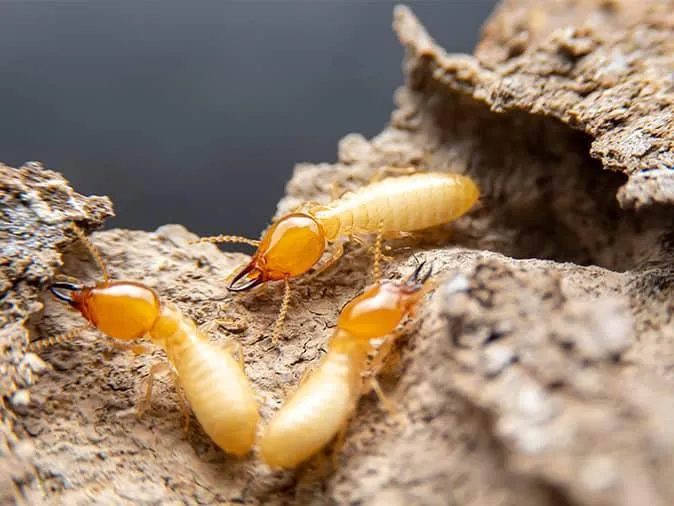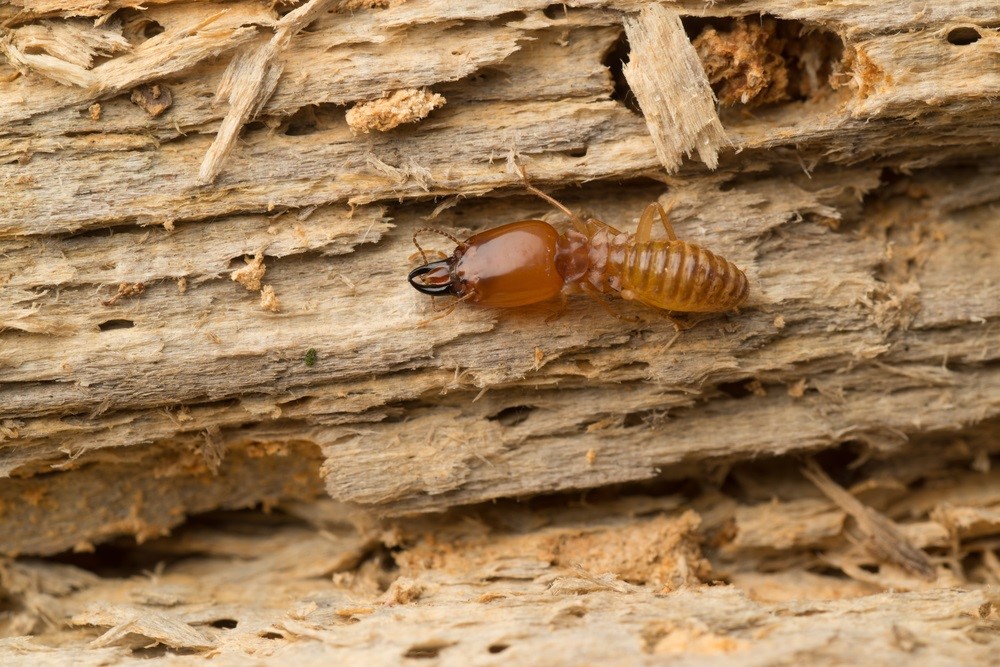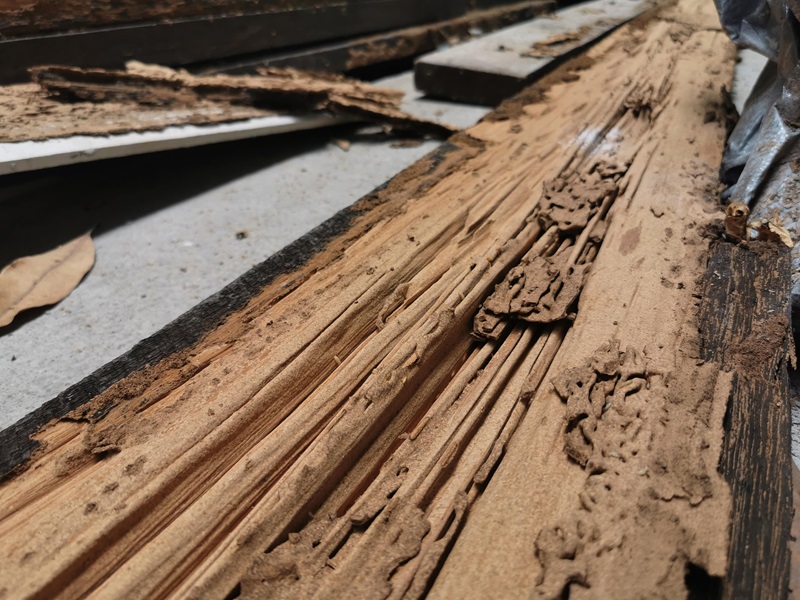Yes, termites eat wood. They feed on cellulose in wood, making them a significant threat to wooden structures and vegetation.
Here’s why: termites have a fascination with eating wood.
- Termites eat wood because it provides a readily available source of cellulose.
- Wood is rich in cellulose, their primary food source.
- Termites have evolved specialized digestive systems to break down wood.
- The cellulose in wood is essential for their survival and colony growth.
- Wood also provides moisture, which termites need to thrive.
- Termites are instinctively attracted to the scent and taste of wood.
The Science Behind Termite Diets

A. Overview of Termite Species
Termites, those tiny, wood-munching insects, come in various species. The most common ones that can wreak havoc on your wooden structures are subterranean, dry wood, and dampwood termites.
These species may differ slightly in their preferences, but they all share a common trait – they feed on wood.
B. Discerning the Feeding Habits of Termites
Termites are relentless eaters, munching away 24 hours a day. They aren’t picky either; they’ll gladly consume it if it’s made of wood.
Whether it’s a living tree, processed wood products, or even that antique wooden furniture you cherish, termites see it as a feast.
C. The Composition of Wood and Why Termites Are Attracted to It
Wood is primarily composed of cellulose, a complex carbohydrate that serves as termites’ favorite meal. Termites have evolved over millions of years, developing special enzymes and harboring microorganisms in their guts to break down cellulose effectively. This cellulose-rich diet is what keeps their colonies thriving.
Intriguingly, termites are drawn to the cellulose in wood for sustenance and because it provides them with the moisture they need to survive. Wood retains moisture, making it an ideal habitat for these insects.
So, in short, termites indeed eat wood, and they do it with a voracious appetite, making them a significant concern for homeowners and property owners alike.
Debunking Misconceptions of Termite Diets
In this section, we’ll address common misconceptions about termite diets and examine the extent of wood damage caused by these tiny but impactful creatures.
A. Common Misconceptions About Termite Diets
It’s essential to clarify some misconceptions surrounding termite diets. One common misunderstanding is that termites eat the entirety of wood structures.
However, the reality is more nuanced. Termites primarily target cellulose within wood, leaving behind the structural components.
Here are some common misconceptions about the termite’s diet and facts about them.
Misconception – 1: Termites Only Eat Dead Wood.
Fact: Termites consume both live and dead wood, threatening all wooden structures.
Misconception – 2: Termites Only Eat the Interior of Wood.
Fact: Termites create visible damage on the surface as they feed on wood internally.
Misconception – 3: Termites Prefer Decaying Wood.
Fact: Termites are attracted to any wood containing cellulose, not just decaying wood.
Misconception – 4: Termites Only Target Old Buildings.
Fact: Termites can infest both old and new structures as long as there is wood to feed on.
Misconception – 5: Small Termite Populations Are Harmless.
Fact: Even small termite colonies can collectively cause significant damage over time, underscoring the need for prevention and control.
B. Investigating the Extent of Wood Damage Caused by Termites
To gauge the impact of termites on wood, consider this: On average, a single termite colony can contain thousands to millions of termites. Collectively, they can consume substantial amounts of cellulose in a given area.
In fact, termites are estimated to cause billions of dollars in property damage annually.
Understanding these misconceptions and the extent of wood damage wrought by termites is crucial for effective pest control and preserving wooden structures.”
Termites and Wood Consumption
This section I’ll dive you into the fascinating world of termite dining habits, providing a comprehensive look at their wood-eating tendencies.
A. Termite Feeding Behavior
You might wonder how these tiny insects manage such a significant feat when it comes to termites and their wood-eating habits. The secret lies in their methodical feeding behavior.
Termites primarily target cellulose, a vital component of wood and plant material. To put it into perspective, they can consume cellulose at an astonishing rate of up to 2.3 milligrams per termite per day.
B. the Digestive Systems and Enzymes Involved
Termites have evolved over millions of years to become wood-eating specialists. Their digestive systems are nothing short of remarkable. Within their guts, they host a variety of microorganisms, including bacteria and protozoa.
These microorganisms produce enzymes that break down cellulose into simpler compounds, such as glucose. This cooperative effort enables termites to efficiently extract the nutrients they need from wood.
C. Factors Influencing Termite Wood Consumption
Several factors come into play when determining how much wood termites consume. Here are the Factors Influencing Termite Wood Consumption:
Wood Type: Termites exhibit preferences for certain wood types, with softer woods like pine being more susceptible to their consumption.
Moisture Content: Termites thrive in moist environments, so wood with higher moisture levels is more attractive to them.
Cellulose Content: Wood rich in cellulose is highly appealing to termites, as cellulose serves as their primary food source.
Wood Accessibility: Wood in direct contact with soil or structural elements provides easy access for termites, increasing the likelihood of infestation.
Environmental Conditions: Warm and humid conditions favor termite activity, making regions with such climates more prone to infestations.
Termite Species: Different termite species may have varying preferences for wood types and conditions, influencing their consumption patterns.
Wood Types Preferred by Termites
A. Identifying the Wood Types Most Susceptible to Termite Infestations
When it comes to the question of whether termites eat wood, the answer is a resounding yes. However, termites are not equal-opportunity wood consumers; they do have their preferences.
To understand this better, let’s delve into the wood types most susceptible to termite infestations.
Softwoods vs. Hardwoods: Termites prefer softer woods like pine, cedar, and redwood more than hardwoods such as oak or cherry. This is because softwoods are typically easier for termites to digest due to their lower lignin content.
Moisture Content: Termites thrive in moist environments, so wood with higher moisture content is more attractive to them. This includes wood in contact with soil or exposed to water leaks and condensation.
B. Factors Contributing to Wood Vulnerability
Understanding why termites are attracted to certain wood types is essential in preventing infestations. Here are some key factors contributing to wood vulnerability:
Cellulose Content: Termites feed on cellulose, which is abundant in all types of wood. However, wood with higher cellulose content is more appealing to termites.
Lignin Content: Lignin, a complex polymer, gives wood its structural strength and rigidity. Hardwoods have a higher lignin content, making them less susceptible to termite damage.
Moisture Levels: As mentioned earlier, termites are drawn to moisture. Wood with higher moisture levels is more likely to attract termites, so maintaining dry conditions is crucial for prevention.
Accessibility: Wood in direct contact with soil or structural elements of a building is more vulnerable because termites can easily access it. Regular inspections and keeping wood away from soil can help.
In conclusion, termites do eat wood, and factors like wood composition, moisture content, and accessibility influence their preference for specific types. Knowing these factors can aid in safeguarding your property against termite infestations.
Signs and Prevention of Termite Damage

A. Indications of Termite Presence and Wood Damage
To protect your property from these wood-munching insects, it’s crucial to detect signs of termite presence. Some key indicators include:
Mud Tubes: Subterranean termites construct mud tubes on walls and foundations, providing them with concealed access to your home.
Hollowed or Damaged Wood: Tap on wood surfaces; termites might be at work if they sound hollow. Also, check for cracked or damaged wood.
Discarded Wings: Termites eat different kinds of wood, both hardwoods and softwoods, as long as it has cellulose.
B. Practical Tips for Preventing Termite Infestations
Prevention is the best defense against termite damage. Here are some practical tips to keep these wood-munching insects at bay:
- Moisture Control: Reduce moisture around your home by fixing leaks, improving drainage, and ensuring proper ventilation.
- Wood-to-Soil Contact: Avoid direct contact between wood and soil, as termites can easily travel from the ground to your wooden structures.
- Regular Inspections: Schedule regular termite inspections with a professional pest control service, especially if you live in termite-prone areas.
- Termite-Resistant Materials: When constructing or renovating, think about using materials like concrete or steel that termites can’t easily damage.
C. Effective Termite Control and Treatment Options
Prompt action is essential if you suspect termite activity or have confirmed an infestation. Effective termite control and treatment options include:
- Chemical Barriers: Applying termiticides around your property’s perimeter to create a protective barrier.
- Bait Systems: Installing termite bait stations that attract termites and disrupt their colonies.
- Fumigation: Tenting your home and fumigating it to eliminate termite colonies.
- Wood Treatments: Treating wood with termiticides or borate solutions to deter termites.
In conclusion, understanding the signs of termite presence, implementing preventive measures, and knowing your treatment options are crucial steps in safeguarding your property from the wood-consuming menace of termites.
FAQs
What types of wood do termites eat?
Termites eat different kinds of wood, both hardwoods and softwoods, as long as it has cellulose.
Do termites only eat living trees, or can they also consume processed wood products?
Termites can eat both living trees and processed wood products such as lumber, paper, and even furniture, making them a significant threat to wooden structures.
Do termites eat wood continuously?
No, termites do not eat wood continuously; they feed on wood intermittently and stop when their colony’s food needs are met.
How can I tell if termites are eating wood in my home?
Signs of termite infestations include damaged or hollowed-out wood, mud tubes on walls or foundations, and the presence of discarded wings from swarmers.
Can termites cause structural damage to a building?
Yes, termites can cause structural damage to buildings by eating wooden components like beams, studs, and floorboards.
Are there different types of termites that eat wood?
Yes, there are subterranean termites, dry wood termites, and damp wood termites, each with slightly different preferences for wood types and nesting habits.
How do termites break down wood?
Termites use enzymes and microorganisms in their gut to break down cellulose in wood, allowing them to digest and extract nutrients from it.
Can termites eat through concrete or metal to reach wood?
No, Termites cannot eat through concrete or metal to reach wood, as they can’t chew the concrete or metal. However, they can find their way into wood by exploiting cracks, gaps, or weaknesses in the building’s structure.
What methods are used to prevent or control termite damage to wood structures?
Preventive measures include regular inspections, treating wood with termite-resistant chemicals, and using bait systems or chemical barriers to deter or eliminate termite colonies.
Conclusion
Termites are known to consume wood, posing a significant threat to wooden structures. It is crucial to address termite concerns promptly to safeguard these structures.
Termites have specialized digestive enzymes that break down cellulose, allowing them to feed on wood efficiently.
While termites can cause extensive damage to buildings, it is essential to note that not all termites consume wood.
Specially treated wood and regular inspections can help prevent infestations, highlighting the importance of proactive measures to protect wooden structures.

